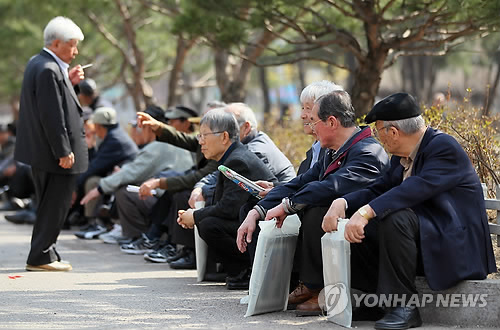Almost half of South Korea’s total population will be 65 or older by 2100 at the current birthrate, a state-run research agency said.
The latest research findings deepen concerns over the country’s fiscal stability and productivity, researchers said.
According to the Korea Institute for Health and Social Affairs, senior citizens will account for 39.4 percent of the population by 2050 and 48.2 percent by 2100 if the country maintains the current birthrate of 1.2 children per woman ― the lowest rate among the OECD countries.
 |
Korean seniors (Yonhap) |
“Korea’s birthrate has been extremely low ― less than 1.3 per woman ― for the last 13 years since 2001, and is very quickly turning into an aged society ― probably the fastest in the world,” said researcher Lee Sam-sik from KIHASA.
“If the current birthrate does not increase, all kinds of problems, including a labor shortage, slow economic growth and fiscal instability, are inevitable. The only solution is to increase the current birthrate, by providing an environment where parents can balance work and family and raise their children without worrying so much about the financial cost.”
At the current birthrate, the country’s overall population is likely to decrease to 22 million in 2100 from 51.65 million in 2026. The productive population ― those aged 15 to 64 ― is to decline from 24.21 million in 2030 to 9.48 million in 2100.
Contributing to the nation’s low birthrate are long working hours, job insecurity and unemployment among young people, whose toughest challenges are the high costs of housing and education.
The so-called sampo generation ― young people who give up dating, marriage and having children because of financial instability ― is what maintains the country’s birthrate at a critically low level, researchers said.
According to KIHASA, only about 35 percent of the unmarried population aged 18 to 49 were dating as of last year. Those who were employed were more likely to be in relationships than those who weren’t. More than half of the population worked more than 40 hours a week, which is at least six hours more than the OCED average of 34.4 hours per week.
“The research findings say while most of the unmarried population wish they were in relationships, the biggest factor that influence their decisions or options are their financial abilities,” said scholar Cho Sung-ho from KIHASA.
In order to increase the birthrate, researcher Lee said more systemic and cultural approach is necessary. Maternity and fraternity leaves are not enough to make a difference, he said.
Affordable housing, guaranteed senior care for today’s productive population, safer day care centers for children, reliable public education, and family-friendly office culture are needed to bring the necessary change, said the scholar.
By Claire Lee (
dyc@heraldcorp.com)








